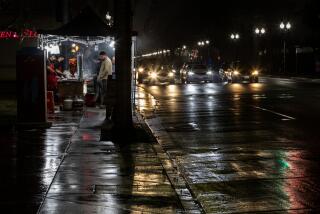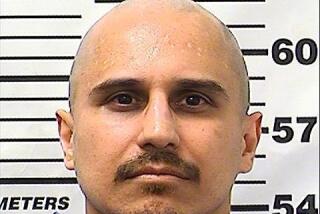Pacoima Man Kills Tagger, but Police Hear 2 Versions
- Share via
SUN VALLEY — In the darkness of a Hollywood Freeway overpass, the culture clash over graffiti became deadly personal Tuesday for Cesar Rene Arce, 18-year-old tagger, and William Masters, observant neighbor.
Arce was shot to death, a fellow tagger was wounded and Masters wound up under arrest on suspicion of murder.
The questions facing them, say police: Did Masters kill Arce in self-defense when he was menaced with a screwdriver in a confrontation over graffiti? Or was Masters really in no danger when he gunned down Arce?
“It’s a touchy issue between use of force and self-defense,” said Los Angeles Police Detective Mike Coffey.
“There are two sides to the story and we can’t tell at this point who’s telling the truth.”
Masters, 35, of Pacoima sat without bail Tuesday in a cell at the LAPD’s North Hollywood Division while the Police Department’s 48-hour clock ticked toward the time when they must set him free or ask the district attorney’s office to press murder or manslaughter charges. Masters has no permit to carry a concealed firearm, Coffey said.
What is clear, Coffey said, is that Masters killed Arce of Arleta and wounded David Hilo, 20, of North Hollywood, Arce’s fellow tagger, as graffiti painters call themselves.
Coffey said Masters, a sometime actor and would-be playwright, told police he was on a regular evening walk along a desolate stretch of Arleta Avenue when he stumbled upon Arce and Hilo spraying graffiti on the Hollywood Freeway overpass shortly after midnight.
Hilo was carrying a screwdriver, police said. Hilo, who was interviewed after he was treated at Pacifica Hospital of the Valley for buttock wounds and released, confirmed that he had the screwdriver, which he said he was using to help him scale traffic sign poles.
Arce noticed Masters writing down the license plate number of the car the two taggers left parked nearby, Hilo said, and ran up to Masters, demanding “give me the number.”
When Masters refused, Arce repeated his demand, Hilo said.
Hilo said he too then began to approach Masters. Arce “was just telling him to give us the number,” Hilo said. “That’s all we wanted, the number. We weren’t thinking about jumping him or robbing him.”
Carrying the screwdriver, Hilo said, he approached to within about 10 feet of Masters, who turned away. Arce then took another step toward Masters, Hilo said. Masters then turned back and shot him in the buttock and Arce in the chest, Hilo said.
As Hilo struggled to get up, Masters walked up to him and held the gun at the wounded man’s head and chest, Hilo said. “This all happened because you were tagging,” Hilo said Masters told him. Masters was unavailable for comment and police would not discuss the version of events that he gave them.
Hilo said Masters then ordered him to roll over onto his stomach. After he complied, Hilo said, he pleaded with Masters--who began pacing back and forth and mumbling to himself--to let him go. Hilo said he began to crawl toward his car and then drove off. “I never looked back,” he said.
Coffey said a passing motorist, whom he did not identify, saw Arce lying in the street and Hilo limping away, and so stopped and tried to help Masters give aid to Arce. Masters “actually gave Arce CPR,” Coffey said, and Masters and the motorist subsequently walked to a nearby gas station and dialed 911.
Coffey speculated that Masters planned to pass on the license plate number to police, but said that Masters does not belong to any of the LAPD’s anti-graffiti programs.
Increasingly, police and city officials have invited the public to join them in their fight against taggers and rewarded them for doing so. Nearly five years ago, the city of Los Angeles began paying $500 rewards for information leading to the convictions of graffiti vandals.
In July, 1993, police in the San Fernando Valley started the Community Tagger Task Force, staffed by hundreds of volunteers who make reports on graffiti in their neighborhoods.
The legal issue facing police, Coffey said, is whether Masters was in “imminent danger” when he fired on the youths, which involves determining whether Hilo went after Masters with the screwdriver and where Hilo and Arce were standing or which way they were moving when Masters fired.
“We’re talking about two taggers being shot and we have not been able to determine whether it was justified at all,” Coffey said.
Hilo said in the interview that he was not using the screwdriver as a weapon and that he had turned around to run away when he was shot in the buttock.
Both points are disputed, police said. “There are inconsistencies with evidence and statements that need to be cleared,” Coffey said. “This could turn around to be something different than it is right now.”
Under California law, a person can take the life of someone who is trying to commit murder or any other felony, including trying to commit “great bodily harm.” Deadly force is also permitted--by any person, not just a police officer--if it is necessary to “apprehend any person for any felony.”
However, in each of these situations, a citizen must also have what the law calls “a sufficiency of fear” that his life is in danger, due to circumstances dangerous enough “to excite the fears of a reasonable person,” state law says.
Neighbors described Masters as a quiet, bookish man who kept to himself. They expressed little sympathy for Arce, saying taggers were a blight in their Pacoima neighborhood.
“Whatever he did doesn’t bother me,” said one 43-year-old neighbor, who asked that his name not be used. “I’m not saying shooting people is the way to do it. . . . But (the graffiti’s) just disgusting.”
Arce’s grief-stricken family, though, said his crime was too minor to justify his death.
“They have no right to write on a wall, but he has no right to take somebody’s life because of that,” said Arce’s sister, Lilia, 19.
Arce’s family said he kept away from gangs, never drank or smoked, and was learning how to work with wrought iron.
Arce’s mother, Mathilde Munoz, spent most of Tuesday lying in her dead son’s bed, wearing his jacket, sleeping with the assistance of tranquilizers.
His stepfather, Usvaldo Munoz, who raised Arce from infancy, said he wasn’t even thinking of Masters on Tuesday, as he struggled to find the money to bury the boy he thought of as his son.
Arce had returned to North Hollywood High School recently to complete his education, interrupted two years ago when he dropped out to work at a Reseda Taco Bell, Caldera said.
Hilo said that he and Arce had met at the high school several years ago.
The two had done some small-time tagging, Hilo said, but nothing major.
They stopped tagging about two years ago, feeling they’d outgrown it, Hilo said. But Monday night they decided to join two 17-year-old taggers. The four rode to the freeway in Hilo’s car, and Hilo dropped the two 17-year-olds off near the freeway, then drove himself and Arce to where the freeway passes over Arleta Avenue.
Arce “told me he wanted to hit that specific spot, because there was a high school near there, and a lot of people would see it,” Hilo said.
More to Read
Sign up for Essential California
The most important California stories and recommendations in your inbox every morning.
You may occasionally receive promotional content from the Los Angeles Times.










